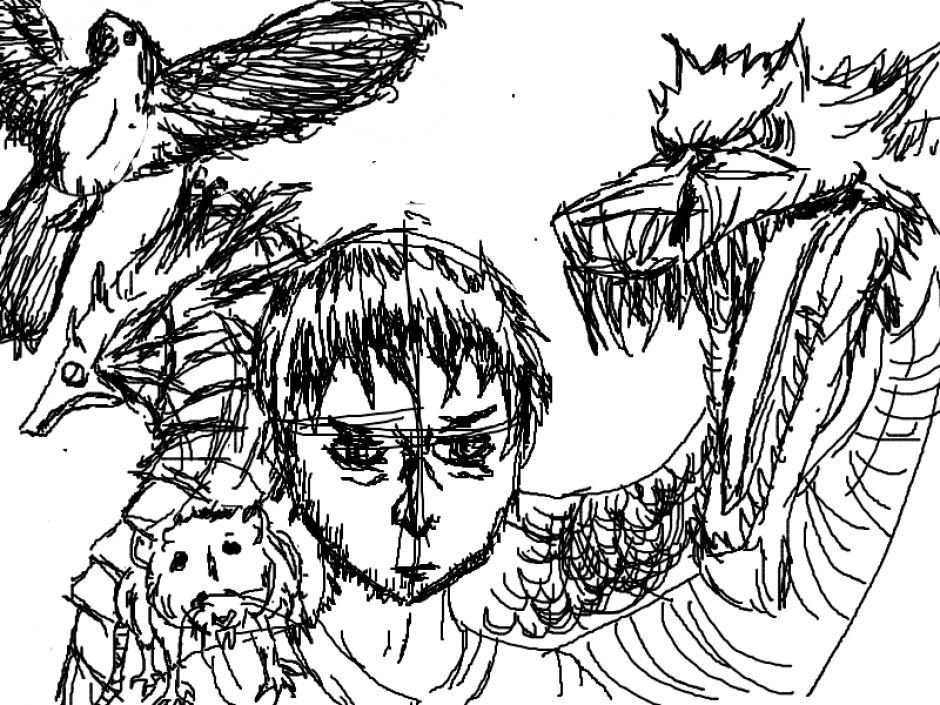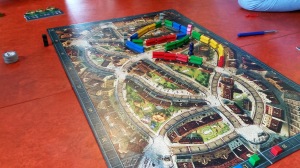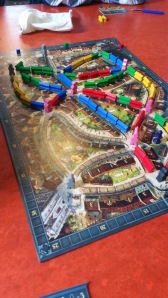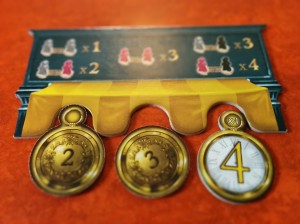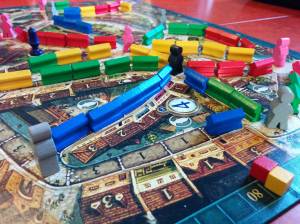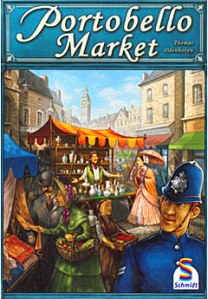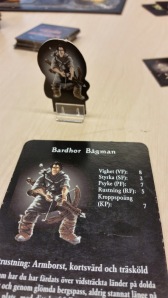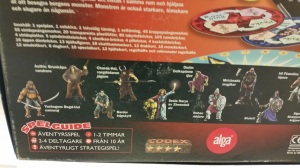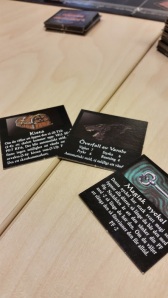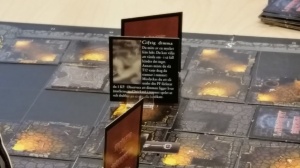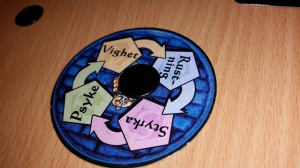Portobello market
London 1921… Market traders gather at the world-famous Portobello Market to set up their markets stalls on the most valuable places. Build your stalls in the most profitable districts and steal the best streets in front of the eyes of your opponent. Bobbyn (police) determines where stalls can be built, but with a little effort, you can move him anywhere.
Parts of the Portobello Market that was good
When you have four players to play with, the game has really good intense mood to it. Not much is up to random, every move you make can be planned beforehand. Games like this you can see who is the best player, because of everything is set in front of the players, and they know everything about their opponent except their strategies.
When you are two players playing Portobello Market you get a lot more points and your strategy change a lot because of it. The game can be finished in just 15 min unlike when you play four players which usually make a game 35 min long. It is also easier to plan out moves, than when you play four players, so one move either win you the game or make you lose it. So you have to be careful what you do.
Portobello Market is easy to learn easy to master, but still it has a lot of things you can do, depending on how many that are playing the game, the gameplay can change drastically, which is nice it gives it more playability.
Parts of the Portobello Market that was bad
Portobello Market is not a bad game, but it has a lot of thing that could be improved, to make it more interesting. One thing that I thought they should have improved is the moving of the bobbyn. When you move him to another district you can lose one point if a player has the majority of that street, you have to pay the player a point. If you have the majority you can walk over a street for free. To me this feels like too little of a punishment, especially if you are two players playing, there is no risk moving him, because it so small amount of points. Also you can’t move him before you have gain any points which make a game slow and a mess in the beginning.
Not getting points for unfinished market stalls in a district. You should get some points for them in the end of the game, like you get in Carcassonne for the left over fields and castles. It just feels you can lose so easy if you start building in one district and suddenly everyone decides to build their market stalls in another district, so if you want to counter them you have to spend points in that district which makes your district you began to build on useless.
Black colored market visitors with a pink one can get you a huge amount of points, so big you can win almost just having a pink and a black visitor. If you are two players you can lose really fast by these colored market visitors.
The core game system is Placing Market stalls /Visitors and Choosing how many moves you should do during that round.
The core components used to play this game are two –four players, market stalls, market visitors, bobbyn, a cotton bag, action tiles, point cubes and the game board.
You have the board showing where you can but down market stalls, market visitors, bobbyn and action tiles. Around the board you have a path to see how much points you have and what position you are in, by placing down a point cube where you are. This works great and makes it easy to remember how far you got.
You have the bobbyn which is placed out on the board in the beginning of the game, after that everyone will start building in that district, until someone gets a point and move out of there to gain the upper hand in the other districts. You can lose points if you are going to jump to another street with the bobbyn, if no one is owning the street you just lose a point if someone else has the majority of that street you lose a point and he gains one, if you have the majority you can jump over for free.
An action tile makes it possible to do actions. Everything cost action points except moving the bobbyn. You can also use an action tile to either double or quadruple your points in one district. Once you placed it down on the board, you get a tile that can’t do this. If you use it like this you can’t make anymore actions that round. So it could also be a risky move if you don’t get a lot of points for it. That is why to keep using your action point tile that gives you four actions last in case you need it for something like this.
Market stalls, this is you core system. Placing them down on the board to get the most points, different squares on the board give different amount of points, so you have to be careful so you don’t give away a square that is worth a lot of points to someone else, that could have a big impact on who will take the lead. You also have to be careful not to start on a new district with not enough market stalls, which could mean you can’t finish a market and you don’t get points for a unfinished market street.
Market visitors and cotton bag, you put all the visitors in the bag and then when you want a market visitor to put it on the board, you pay one action point. You put them in the end the district row to get points. The visitors have different colors; Grey, pink and black. The grey is the one worth least points. And the black one is worth the most. So if you have two grey ones you only get the points for the market stands you have there. If you have one grey and pink, you get double the points. If you have two pink you get triple the points a grey and black is the same amount. A pink and a black is quadrupled the points. Players are drawn to districts that is worth the most, and that is where the gameplay is best.
Target group interpretation
Well this is a very solid game, it is not too long (never longer than 35 min), it is easy to learn. It says it is form 8 years old. I would say this is a family game, but could find anything about it being sold in a major toy-store, it may be bigger in Finland because the company is from there, but I couldn’t anything about that.
Well if you look at the front-case, it looks really boring and uninteresting. To me it looks like it has more to do with a police solving mysteries in Portobello Market than me building market stalls. It is not until you check out the back-case you starting to get a hint of what kind of game it is. Portobello is like a mix of Carcassonne and Monopoly, but an easier version of them. I like these kinds of games, so for me, someone that do not play a lot of board games but like to play strategy games on the pc, it feels like its a game for me.
Anyone that wants to play a simple game, a game for a family or a group of inexperienced board-game players, this is the game for you.
Summary
The most interesting part of the game is the strategy part. You can plan moves beforehand with only the players being the thing that can ruin your strategies. The game is short but there is a lot of playability because of it. You can probably play two –three games before you lose interest. There is not that many rules so new players can jump in and learn them fast. If no one knows anything about this game I hardly think you would buy this and instead buy a more famous board game or just play monopoly, because a lot of people know how monopoly works.
There are a few ways to get points in this game, like action tile multipliers can be very overpower in one vs. one games, and if you get the black colored visitor and have the majority in that street you pretty much win the game. The board has a lot of details to it and is nice to look at, especially when you have all the colored market stands out on it, it looks very appealing. It has some balance issues like in a two player game it is really easy to fall behind if you make one mistake, but the games are short so I guess you could play several times. None of the game components feels useless; they are easy to use and easy to understand. That is what can make anyone win even if you plan your moves, someone can ruin it making a district where you have the majority of market stalls, by putting two grey visitors there, but you can counter that using action tile giving quadruple points for every market stalls in the district and that way making a lot of points. It’s moves like these that are making the game so exciting.
The thing with moving around the bobbyn can be slow at first for a group of beginners, because you are not really sure of what to do with him and if it will benefit you, but after awhile or after a few games it becomes naturally and you can see the advantages of moving him around. For example to be able to first start on a district can make you have majority of it which is great.
I would recommend playing it for its simplicity.
A L-A
Drakborgen Legenden

Drakborgen Legenden
I and my group had to choose a board game that we had to play and then analyze. My group
choose Drakborgen Legenden. Drakborgen Legenden is sort of a remake of Drakborgen that is a Swedish board game in a fantasy environment that was published by Alga 1985. The Expansion Drakborgen II came 1987. The game is created by Dan Glimne and Jakob Bonds and was inspired by role playing games like Dungeons & Dragons.

Here is a short explanation on how the game works.
The goal of the game is that you have to get into the castle where the dragon is sleeping. Steal parts of the dragon’s treasures and get out of there before the sun goes down. The castle consists of rooms made on tiles spread all over the board creating a randomized labyrinth. These labyrinths are built gradually as the player draws and place a new labyrinth tiles as the player gets deeper in to the castle. Even the rooms’ content is randomized by card drawing. a room for example can contain valuable or useful objects or things that could prevent the players progress, like monsters and traps.
The games main element of excitement lays in that a) the Dragon can wake up and spit fire all over the intruders, b) time is short. Players who succeed to get out of the castle with most valuable treasures wins the game.
The best parts of the game:
- Risk/reward system in the dragon room.
When you are inside of the dragon room and the dragon is asleep, you get to take on treasure that could be worth a large sum of gold coins, and after that you have to pick a dragon card to see if the dragon wakes up or not. There is eleven card of the dragon sleeping and only one card of the dragon waking up. If the dragon is sleeping you repeat same thing again or get out of the before someone else picks a dragon card that makes the dragon wake up, because then you are trapped there and may not get all of your treasures out or get out of there alive. - Every time you play it feels different.
With so many characters you can choose from and so many objects, for example throwing weapons, armor, healing items, magic rings, amulets and gold coins and many more. The characters also have different stats and abilities. - Reward for exploring.
As I said before there are many items in this game and so to get those items you have walk into different room, but you don’t know what’s in that room until you turn the room tile. After that you will ether get something good or you may meet a dangerous monster or walk into a spider web or poisonous gas.
The worst parts of the game:
- Tile placement on the board causes frustration in players since slightest movement/touch of the tiles causes the whole board to be readjusted.
- Combat feels dull. The action of combat are not represented well enough through the combat in the game. Using a circled tile you choose between strength, intelligence, agility and armor. Strengths beats intelligence, intelligence beat agility, agility beats armor and armor beats strengths. If you get on the same stat, the one with the highest stat wins and the monster or player lose the difference in health. It is just the way you do it that is not working. You have to cover the tile with you hand and chose one of the stats on the tile, and then show the other player what you chose. This could go on for a long time if they have a lot of health, and do not choose the same tile.
- PvP combat is not encouraged since there is no gain.
What this means is if you manage to kill another player you don’t get there items. The risk is higher than what the reward is if I win.
The core game system:
The core game system is to explore tiles, to find items and reach the dragon to gain as much gold coin as possible.
The core game components to play Drakborgen is, 2-4 players, room tile cards, labyrinth tile card, character card explaining your characters abilities items and what stats he has, dragon cards, treasure cards, fighting tile where you fight you battles, monster card explaining what the monster will do and their health points, health point tiles. Magic cards for the wizard, magic rings for the players, sun tile to show how much time there is left and a 6 sided dice showing how There clouds and three suns and a normal 6 sided dice, to roll certain things in the game.
Characters:
The game is played that each player choose a character, some characters are better at fighting monsters while others are better getting through rooms, traps and doors, it is up you how you want play.
Gold coins and treasures:
Players wants to have the most gold coins before the time runs out. This is one of two ways, to win, the other one being if you are the only one alive in the end of the game.
Sun tile:
When everyone has done their turn you roll the dice to see if it is cloudy which mean no time is moving and if it is a sun you will move the sun arrow to show that time has passed. If the sun goes done everyone left in the castle dies. This is a way to make the player think before he moves and not feel safe in the castle.
Dragon room:
Each player starts in the corner of the castle and everyone moves towards the middle where somewhere the dragon and his treasures are hidden. The Dragon is important part of the game; here is where risk and reward really shines. You always get a treasure as long as the dragon is asleep, if you wake it up by picking a dragon card, you have to either escape the dragon room, but you can then lose treasure or stay and fight remember the dragon has almost impossible stats to beat.
Labyrinth tiles/room tiles:
Every turn you can move your character one labyrinth tile. You can go anywhere as long as there are no walls in your way, the walls there could be a hidden passage, if you have right symbol to do so. Each game you roll to see what symbol will be the hidden passage, which means you could walk through that wall. Most labyrinth tiles have red dot on them which means there is a room tile there. Room tiles can have items, gold coins, traps or monsters under them.
Items:
Items can help you fight monster or get through traps and doors.
Monsters:
Monsters can either run away from battle, choose not to fight or stay and fight. When you fight a battle you use your fighting tile to see if you or the monster wins. Some items that can help you against monsters are throwing weapons and items that make you stats better. There is special monsters that if you beat the you could get better stats or more gold coins, but those are rare but worth fighting.
With so many things that could stop you or kill you, you have be careful where you go. But there are so many random elements in this game that it is hard to plan what to do. It becomes more of a game of luck than anything else.
Who is this game for?
I think this game is made for people that like fantasy games possibly table-top role playing games. This game may not have the role playing element, but it has some of the other things that make it a table-top rpg game for example the exploring, finding items and gear to help you on your journey through the castle. What makes this game easy to play is that you don’t need a game master to play it, which means you can start playing whenever you want. You don’t need a big group for it to be fun either.
What makes this game more boring and frustrating is how slow and long it is. A campaign can take up to three hours. You rather avoid combat because how clunky and slow it is to kill someone. Also because of the system with rolling the sun dice to see how much time as gone by, it really does not work. All our games we just rolled a lot of clouds which meant we could ignore the time. With so many things that could stop you or kill you, you have be careful where you go. But there are so many random elements in this game that it is hard to plan what to do. It becomes more of a game of luck than anything else. Backtracking on the same labyrinth tiles you have already walked on is useless. There are no more items there or monsters, which makes it boring when nothing happens for three- five turns, you should have some kind of system that makes it possible to roll a dice and see if there is a chance they will find or fight something in that room. Fighting most of the enemies feels useless to because you don’t get anything from them, they don’t drop any loot. There are some enemies that do but it is so random and rarely do meet any special monsters like that. Killing another Player also feels useless. I wish I could loot their bodies if I killed them so I felt rewarded. Doors can be too hard to open, you have to roll a dice two times and both times it has to succeed for you to be able to open the door. The game does not have an aesthetically appeling look to it, every room looks the same.
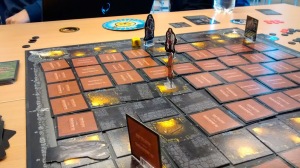
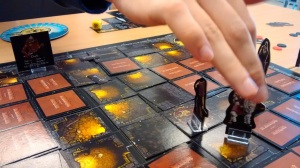
The things that keeps this game together is the Variety of different classes you can choose from. Now some classes feel a bit better than others. Ít feels like more playtest should have been done. Now I will say that when there are only two players left the dynamic shifts and the game moves much faster. You roll the sun dice faster because of the tempo of the game is faster. Which mean time feels faster.
Drakborgen has great thing going for it like the discovery, challenge, fantasy setting, but it just miss some of the thing that could have made it a great board game.
